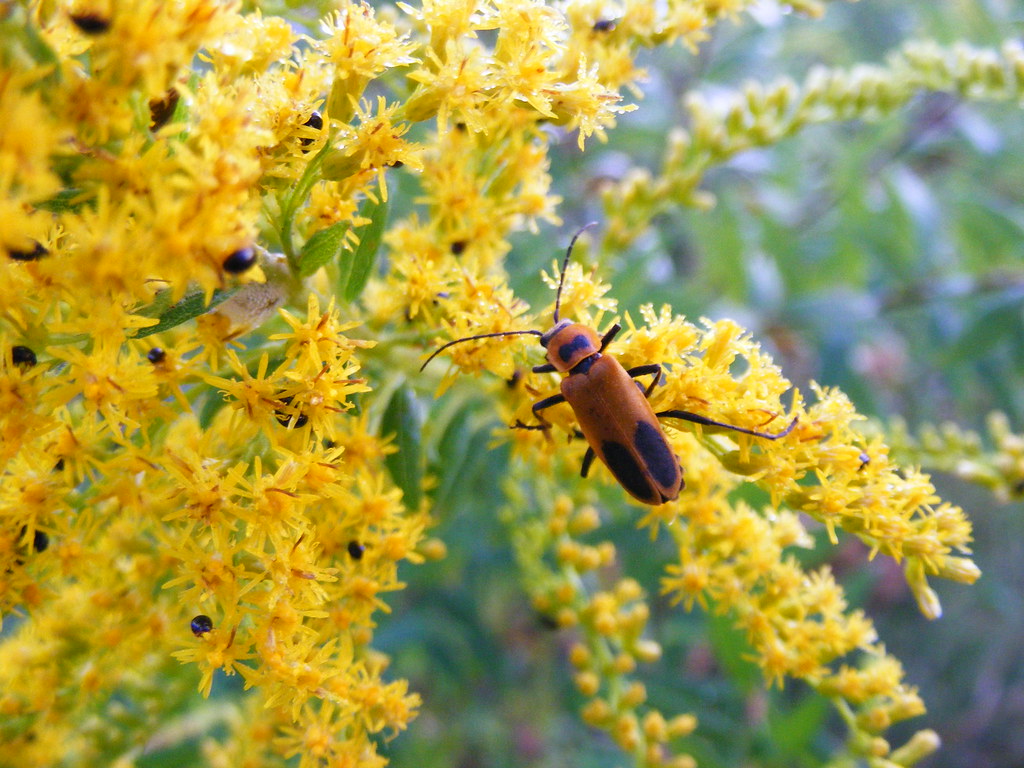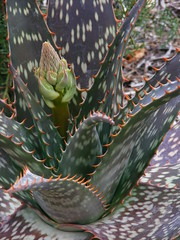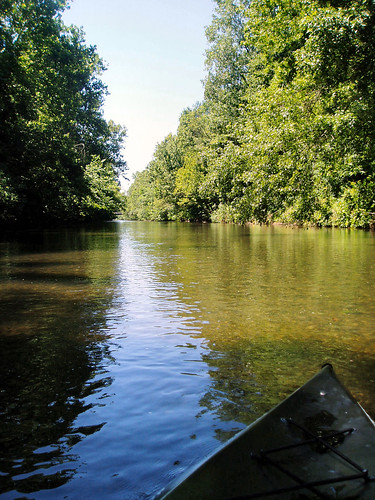I had no idea what sort of beetle this was when I photographed it in Glenwood Gardens last week, but as it was helpfully perched on a goldenrod flower, that did help me narrow it down. I was able to find it by looking through the beetle families on Bug Guide's helpful web page.
Soldier beetles are a large family, there being somewhere around 450 species in North America alone. The larval stage lives in leaf litter and is carnivorous, while the adults are nectarivores feeding primarily on nectar, pollen and sometimes aphids. Soldier beetles are also nicknamed "Leatherwings" for their soft, cloth-like wing coverings. In shape and size they resemble fireflies, to which they are closely related.
The Goldenrod Soldier Beetle, as the name suggests, are often found on goldenrod flowers but they'll also feed on other late summer blooming flowers such as asters and sunflowers. They are welcome addition to any garden as the larva eat other pest species and the adults are great pollinators.
Showing posts with label wildflowers. Show all posts
Showing posts with label wildflowers. Show all posts
Saturday, September 05, 2009
Thursday, August 14, 2008
American Lotus at Cowan Lake
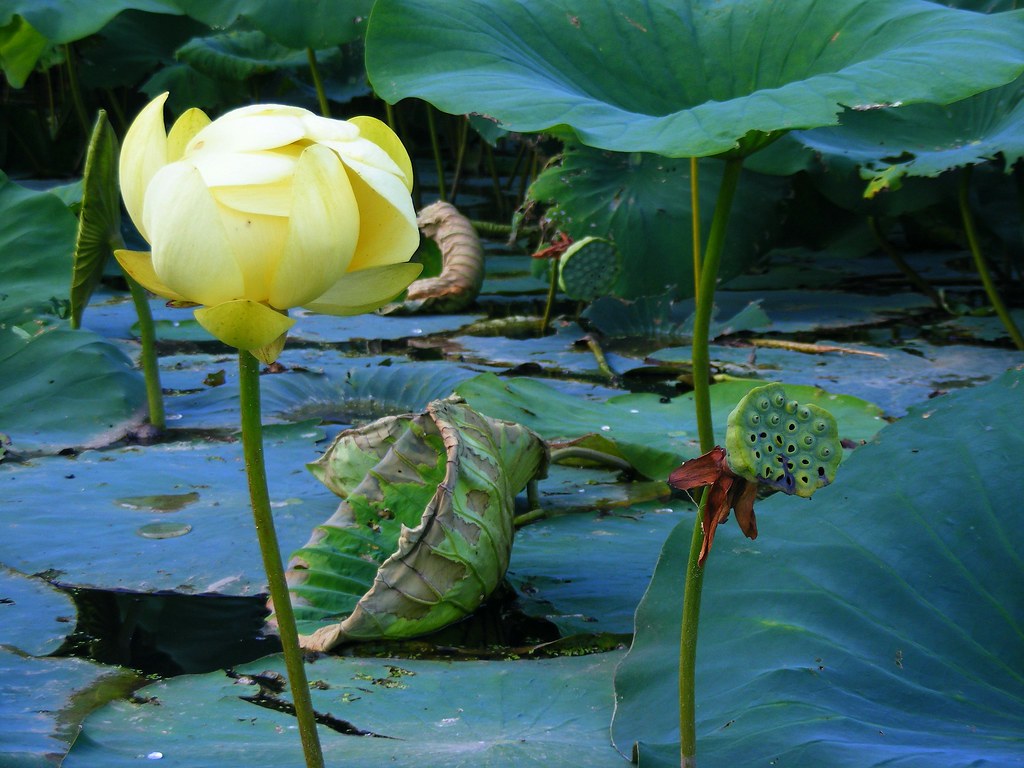 Last night I joined the local chapter of the Sierra Club for a paddle around Cowan Lake to see the American Lotus in bloom. There are acres of them located along the shores of the eastern portion of the lake! They are simply stunning; the leaves grow up to two feet across and some lie on the surface of the water while others rise as much as two feet above. The flowers are big and showy, creamy yellow and up to ten inches across and are supposed to be the largest American wildflower.
Last night I joined the local chapter of the Sierra Club for a paddle around Cowan Lake to see the American Lotus in bloom. There are acres of them located along the shores of the eastern portion of the lake! They are simply stunning; the leaves grow up to two feet across and some lie on the surface of the water while others rise as much as two feet above. The flowers are big and showy, creamy yellow and up to ten inches across and are supposed to be the largest American wildflower.American lotus seeds can remain viable for up to four hundred years! The seeds and rhizomes were used by Native Americans as food and it is believed they deliberately spread the plant northward from its original range. In most parts of North America, they will begin to bloom in mid-June to mid-July and will continue to bloom on into autumn.
The 700 acre Cowan Lake is excellent for paddling, as it is restricted to a 10 hp limit. Canoe rentals are available and there is also a Lotus Cove boardwalk trail from which to view the lotuses without getting in the water.
There are lots more photos in my Cowan Lake Paddle set on Flickr
Labels:
American lotus,
Cowan Lake,
kayaking,
lake,
lotus,
nature,
Ohio,
state parks,
wildflowers
Wednesday, May 21, 2008
Columbine
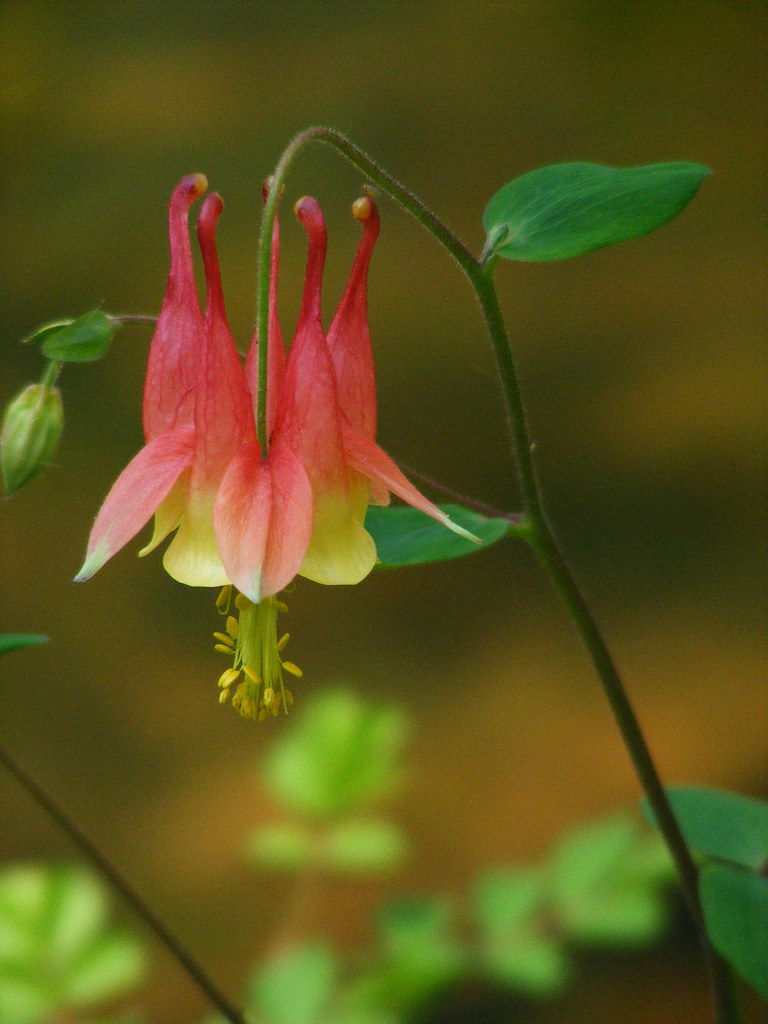 One of my favorite Ohio wildflowers blooms this time of year. The wild columbine prefers thin soils and can be found clinging to the sides of cliff faces and boulders in woodlands across Ohio. Their flowering coincides with the first arriving hummingbirds, which are well adapted to reach the nectar stored in the upper ends of the long spurs of the blossom.
One of my favorite Ohio wildflowers blooms this time of year. The wild columbine prefers thin soils and can be found clinging to the sides of cliff faces and boulders in woodlands across Ohio. Their flowering coincides with the first arriving hummingbirds, which are well adapted to reach the nectar stored in the upper ends of the long spurs of the blossom. The flower takes its name from columba, from the Latin word for dove. Some early aficionado thought the flower's unique shape resembled a group of doves perched around a fountain. The genus of the flower also takes its name from a bird; Aquilegia is Latin for "eagle-like" and refers to the resemblance of the flower to an eagle's talons.
In legend, the columbine is considered to be a symbol of foolishness, because the flower looks like the flounced hat of a court jester. It is considered to be bad luck to give a columbine to a woman for this reason. The wild columbine is also associated with a legend of the Virgin Mary. The fallen petals look like tiny slippers and it is said that columbine plants arose wherever Mary stepped on her way to visit her cousin Elizabeth, so sometimes columbine goes by the common name Our Lady's Shoes or the Virgin Mary's Shoes.
There are many domesticated cultivars of columbine, the flowers of most of which are upturned, but my favorite remains the lovely nodding flowers of the wild columbine. The fact that they grow in some of the prettiest spots in Ohio is probably no small factor in my preference.
Saturday, April 12, 2008
Bloodroot
 Bloodroot (Sanguinaria canadensis) is blooming in our area now, but I've been thwarted in my efforts to get a decent photo this year. I have one good picture of the blossom and another of the leaf, but not both at the same time.
Bloodroot (Sanguinaria canadensis) is blooming in our area now, but I've been thwarted in my efforts to get a decent photo this year. I have one good picture of the blossom and another of the leaf, but not both at the same time.Bloodroot is so named because when the root is damaged it emits a blood red juice. This liquid was used by Native Americans as a dye for baskets and clothing and for painting their faces and bodies.
 Although, or perhaps because, the plant has toxic properties it has long been used as a medication. Bloodroot is known to contain an escharotic, a substance that kills tissue, and the juice has been used in preparations to kill ringworm, fungal growths and warts. It is also used in mouthwashes to kill gingivitis and plaque. Despite its useful properties, self-medication is an exceedingly bad idea due to the plant's poisonous substances. It's far too lovely a plant to destroy in any case.
Although, or perhaps because, the plant has toxic properties it has long been used as a medication. Bloodroot is known to contain an escharotic, a substance that kills tissue, and the juice has been used in preparations to kill ringworm, fungal growths and warts. It is also used in mouthwashes to kill gingivitis and plaque. Despite its useful properties, self-medication is an exceedingly bad idea due to the plant's poisonous substances. It's far too lovely a plant to destroy in any case.
Labels:
"Cincinnati Nature Center",
Bloodroot,
flora,
hiking,
interesting,
nature,
wildflowers
Sunday, April 06, 2008
Spring Ephemerals
I finally ponied up the money and purchased a membership to the Cincinnati Nature Center. It's one of my favorite places to hike in the area and today I squelched my way across the two and a half mile Redwing Trail. I found lots of Harbinger-of-Spring (pictured) and Trout Lilies blooming in the woods, though it's still a week or so too early for other spring ephemeral wildflowers. Trillium, Dutchman's Breeches, Bloodroot and several others were above ground but still in bud today. We are expecting a warm week so next weekend should be peak time to take in these fleeting blossoms.
The morning started off chilly but quickly warmed as the sun rose higher into the sky. I happened to be hiking along a stream bed surrounded by a meadow when the temperature passed a certain threshold and suddenly the air was filled with the calls of Spring Peepers. That is the sort of thing that makes getting up before dark on a Sunday morning and heading out into the woods completely worthwhile.
The morning started off chilly but quickly warmed as the sun rose higher into the sky. I happened to be hiking along a stream bed surrounded by a meadow when the temperature passed a certain threshold and suddenly the air was filled with the calls of Spring Peepers. That is the sort of thing that makes getting up before dark on a Sunday morning and heading out into the woods completely worthwhile.
Labels:
"Cincinnati Nature Center",
"Spring Peepers",
ephemerals,
flowers,
frogs,
hiking,
nature,
spring,
wildflowers
Thursday, March 06, 2008
Blue-Stemmed Goldenrod
It's not the greatest photo in the world, I know. Back in the old days, before I carried a digital camera on all my hikes I used to carry several field guides in case I came across a bird/tree/flower/mushroom I didn't know. It made for a very heavy pack. Now I take pictures of the things and identify them later. Sometimes much later. I took this photo last October and have just now got around to looking it up. As best I can tell, this is a Blue-stemmed Goldenrod (Solidago caesia). I found it growing in Indiana Dunes National Lakeshore park (which is a lovely place) and there was a lot of it around at that time of year.
In other news I had my yearly performance evaluation at work today. It was all very positive; there were about a dozen anonymous comments from various co-workers singing my praises and saying how much they like working with me. I'm going to file them away and pull them out on those days when I feeling all blue and unlovable.
In other news I had my yearly performance evaluation at work today. It was all very positive; there were about a dozen anonymous comments from various co-workers singing my praises and saying how much they like working with me. I'm going to file them away and pull them out on those days when I feeling all blue and unlovable.
Labels:
flowers,
hiking,
indentification,
life as I know it,
nature,
parks,
travel,
wildflowers
Subscribe to:
Posts (Atom)
